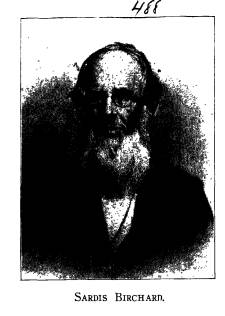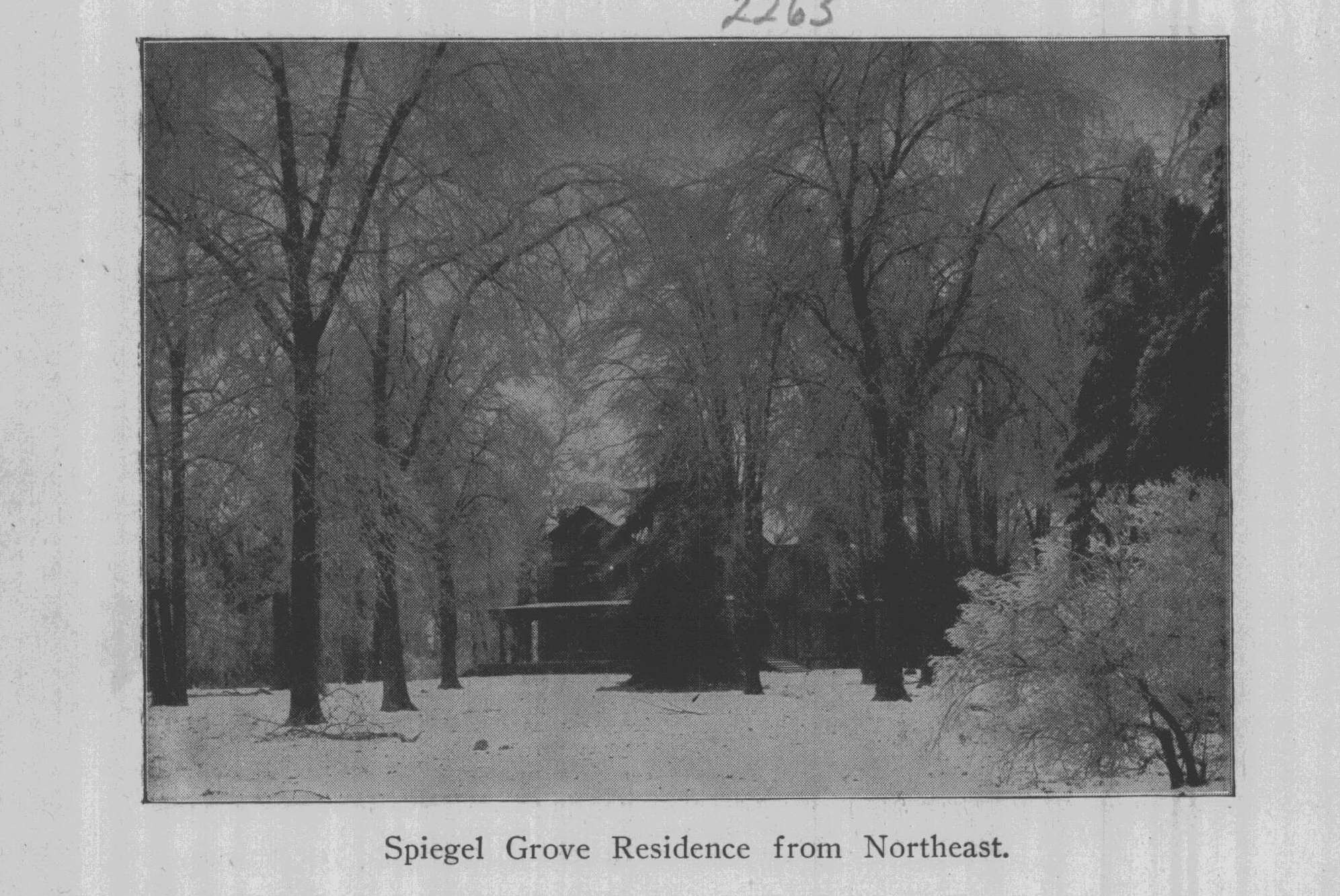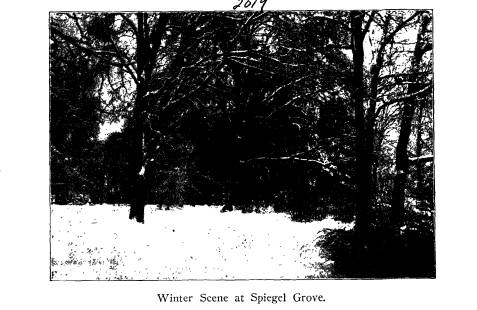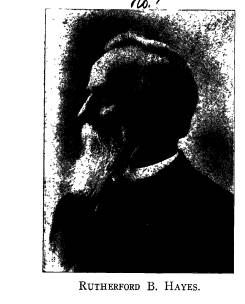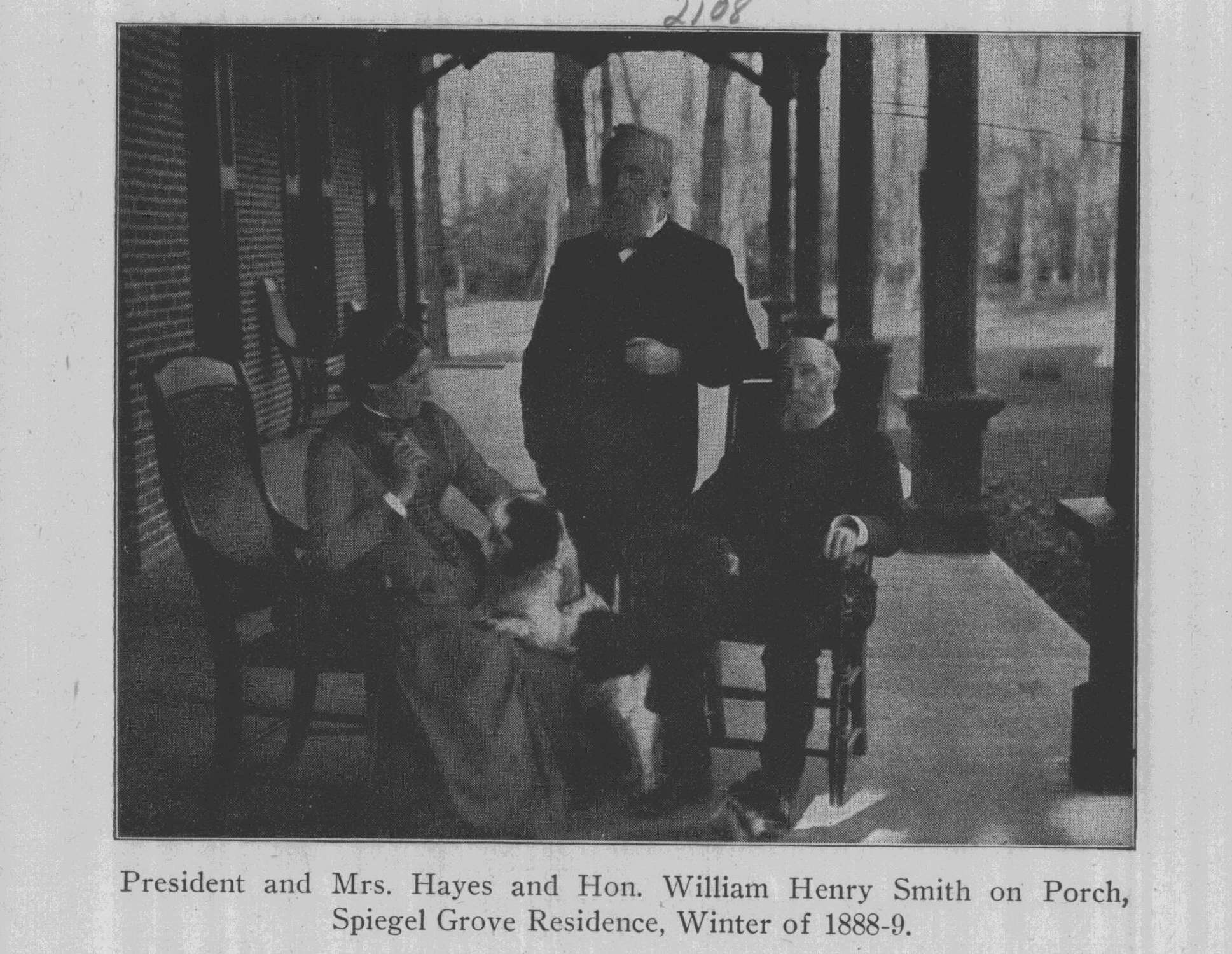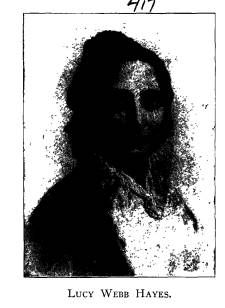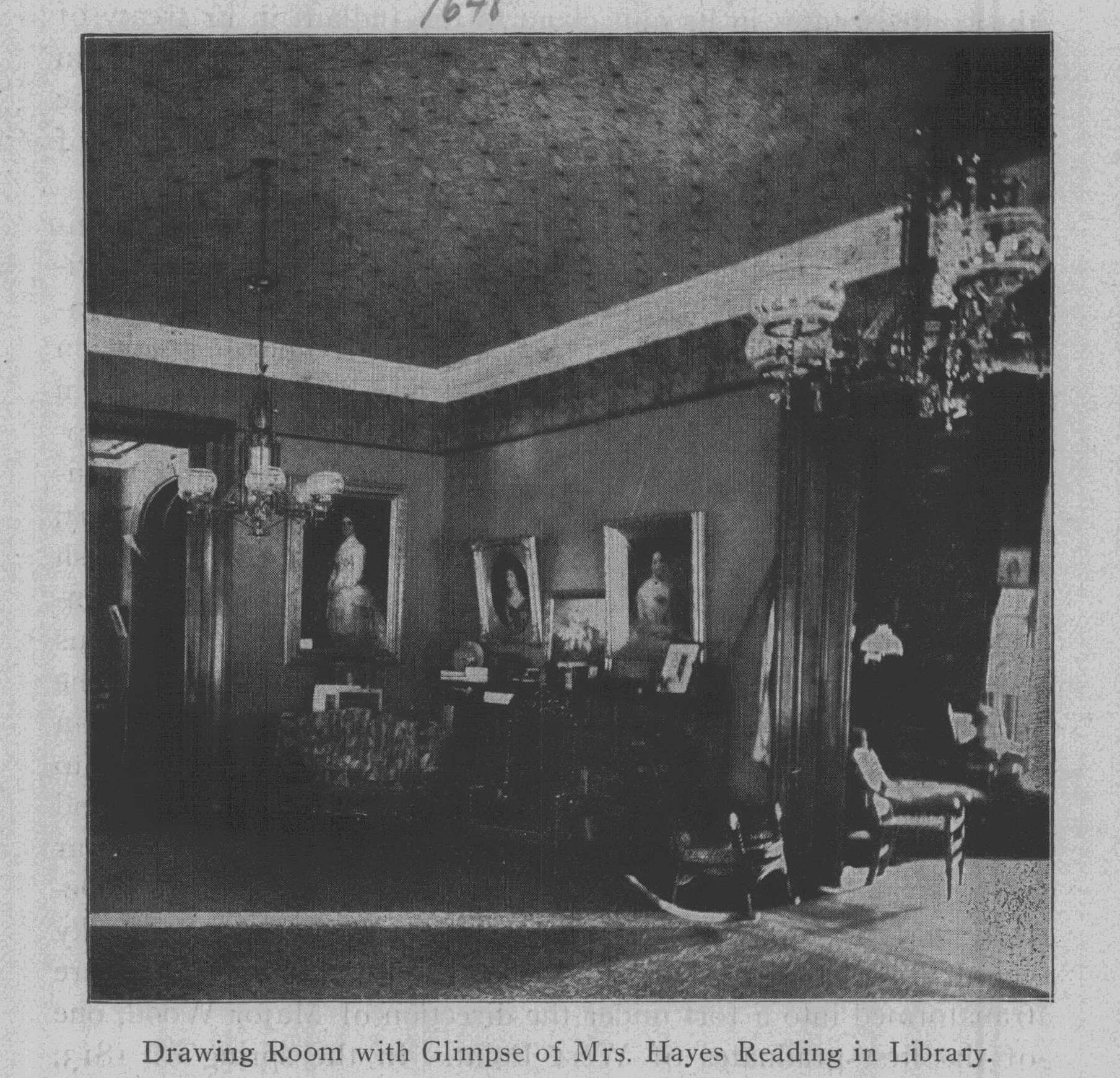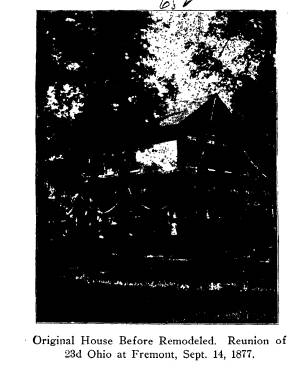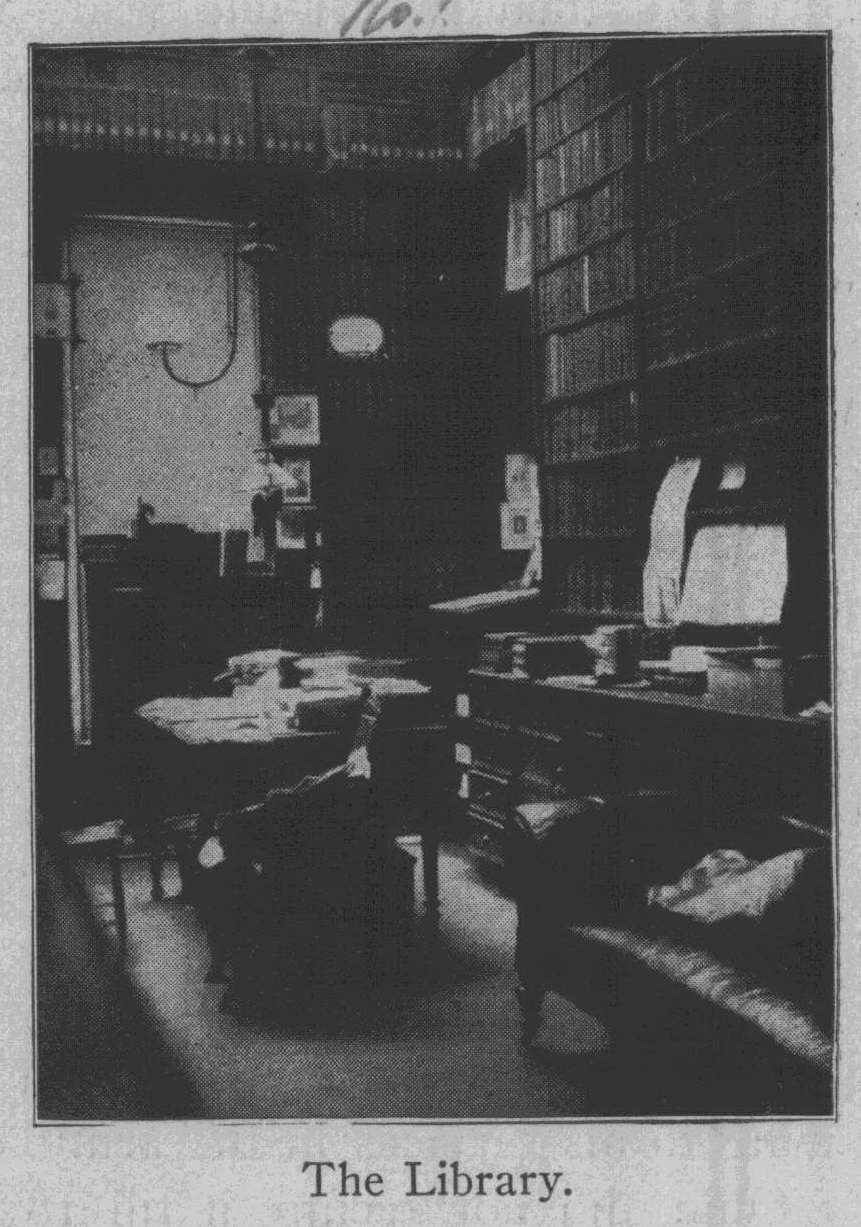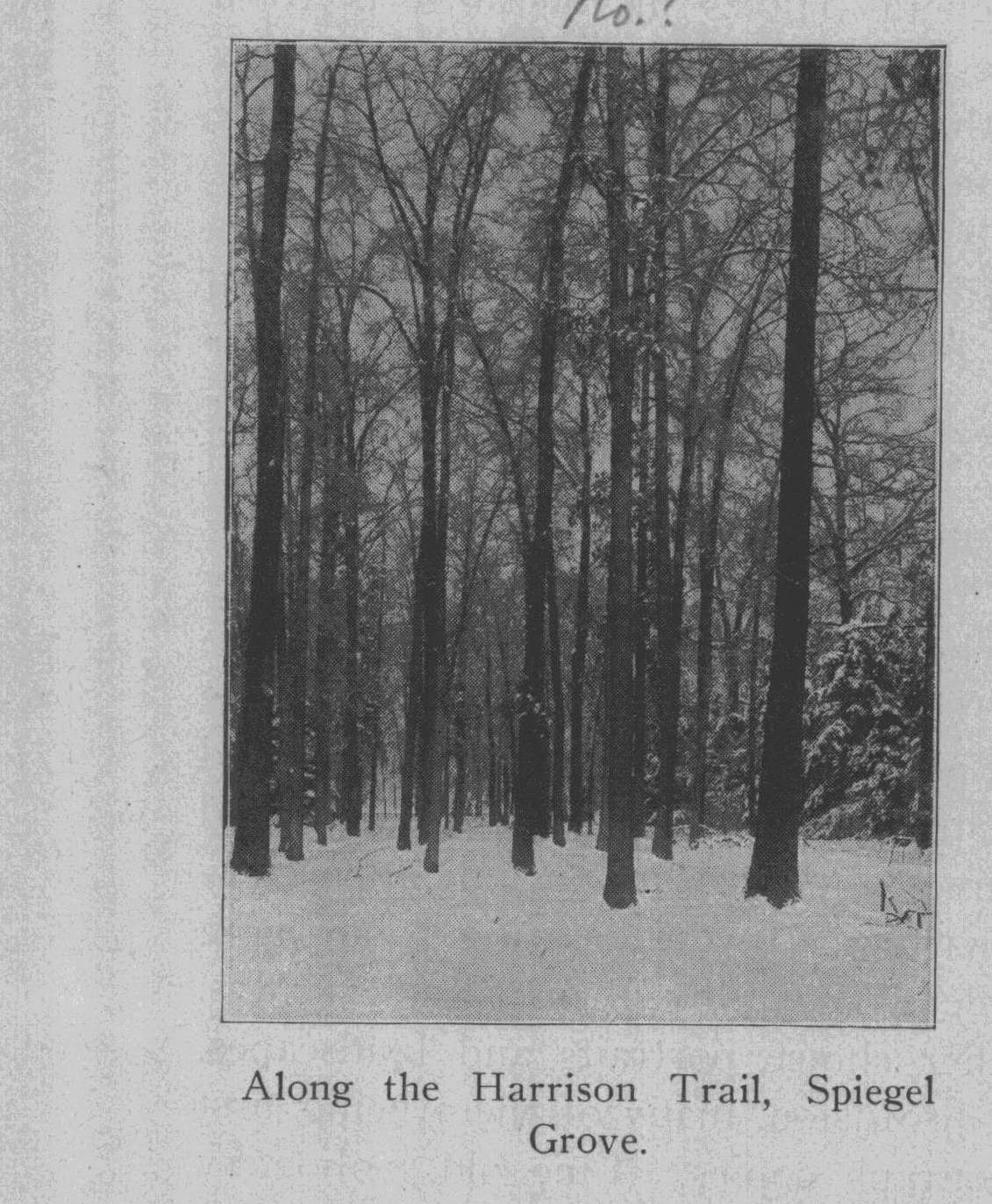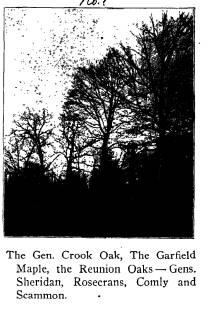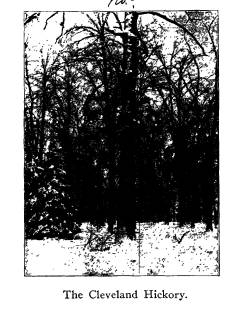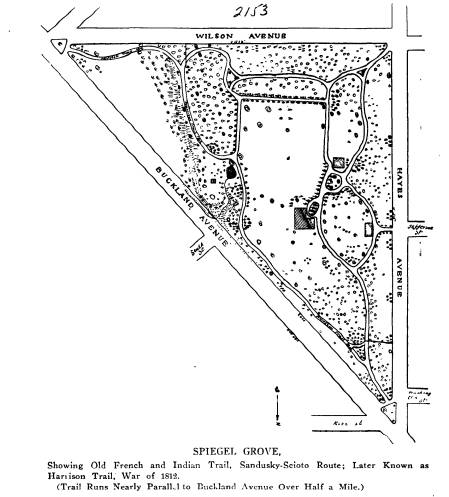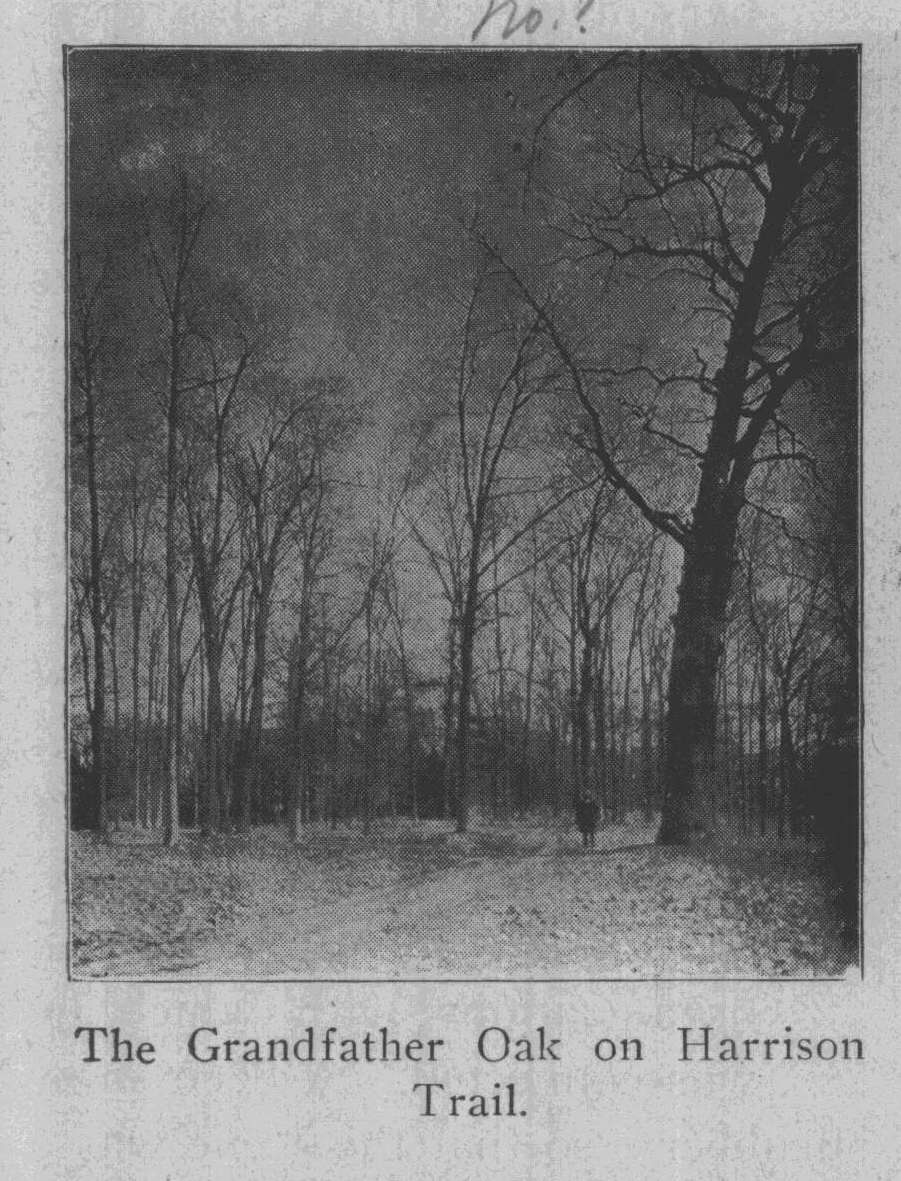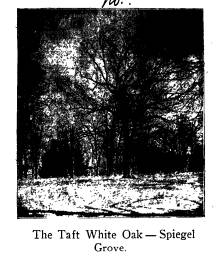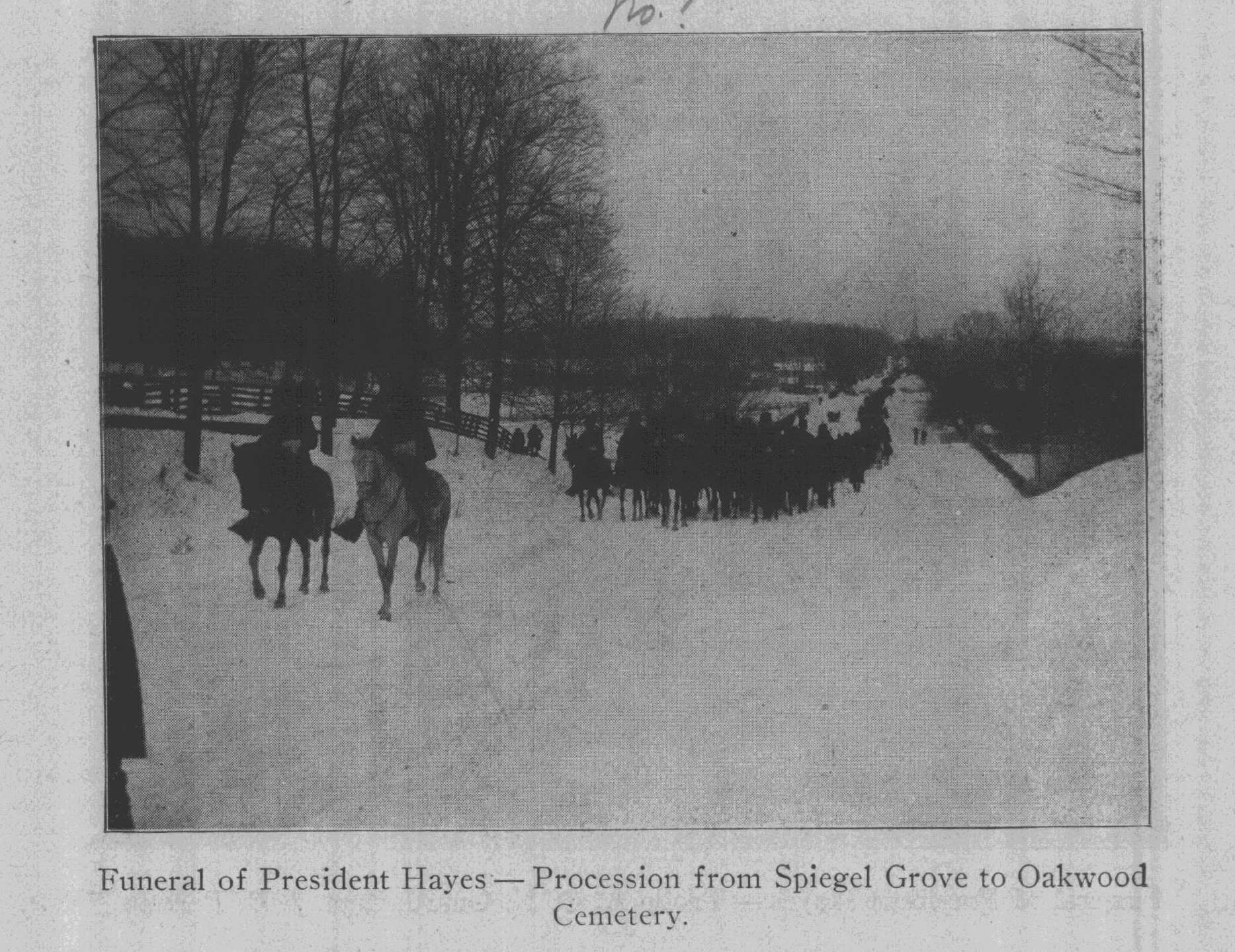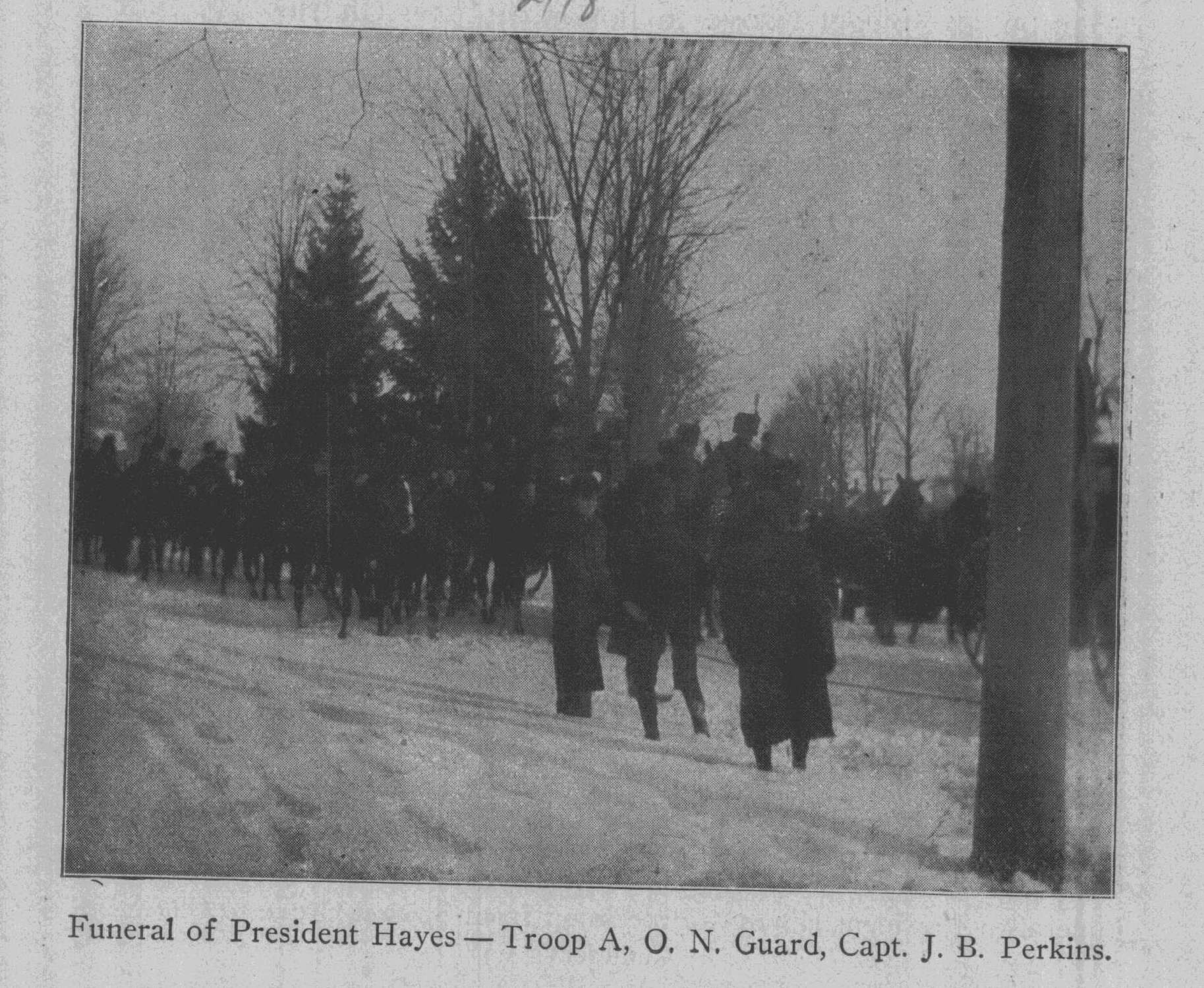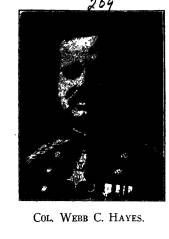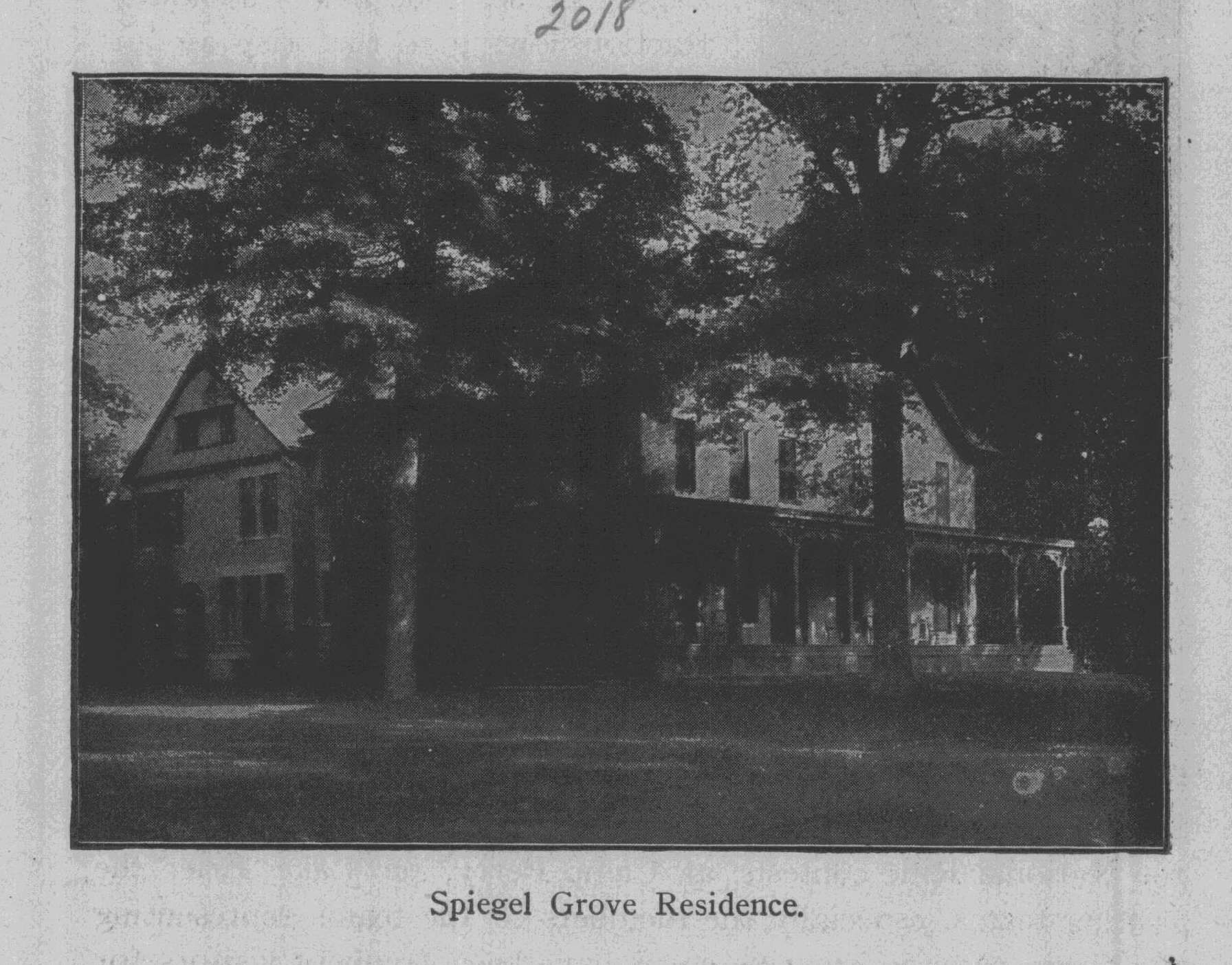Ohio History Journal
- 1
- 2
- 3
- 4
- 5
- 6
- 7
- 8
- 9
- 10
- 11
- 12
- 13
- 14
- 15
- 16
- 17
- 18
- 19
- 20
- 21
- 22
- 23
- 24
- 25
- 26
|
SPIEGEL GROVE THE HOME OF RUTHERFORD B. HAYES.
LUCY ELLIOT KEELER. Memorials take many forms, and the gift to the State of Ohio, for the Ohio Archaeological and Historical Society of that |
|
portion of Spiegel Grove, the beautiful homestead of President Hayes, through which runs for a half mile the old Harrison Trail of the War of 1812, is one of the most interesting, com- mendable and generous gifts of recent years. The deed from Colonel Webb C. Hayes to the State of Ohio for the Harrison Trail State Park, now a por- tion of Spiegel Grove, con- veys about one-half of the Spiegel Grove property and reads: "To have and to hold to the State for the use and benefit of the Ohio Archaeological and Historical |
|
Society, so long as the premises shall be maintained as a State park, in which the old French and Indian trail along the San- dusky-Scioto water course from Lake Erie to the Ohio river, later known as the Harrison Military Trail of the War of 1812, shall be preserved in its present location and maintained as a drive, in which the trees, shrubs and flowers now growing in said park shall be preserved and cared for, and together with such 345 |
|
|
|
346 Ohio Arch. and Hist. Society Publications. other trees, shrubs and flowers as may hereafter be planted in said park shall be properly marked with the scientific and com- mon names so as to be instructive and interesting to visitors." Furthermore: "The Grantor reserves the right to transfer the remains of Rutherford B. Hayes and Lucy W. Hayes to the knoll in the premises hereby conveyed in Spiegel Grove, to be placed in a granite block beneath the monument heretofore de- signed and erected by Rutherford B. Hayes in Oakwood Ceme- |
|
tery, Fremont. The said monument together with such im- provements as shall be placed around it shall be preserved and maintained forever, but no building or structure, save the monu- ment, other than a suitable enclosure from the public roads or around the monument, shall be erected in said park without the consent of the Grantor in writing." In the will made by President Hayes but a short time before his death, he bequeathed, at the request of his children, Spiegel Grove and all the personal property connected therewith to them |
Spiegel Grove. 347
to be held in common without sale or
division. Five years later,
the Ohio Archaeological and Historical
Society, of which Presi-
dent Hayes was the president at the time
of his death, issued a
confidential circular with a view of
securing the property with its
valuable library and collections which
had been tendered them on
the sole condition of raising an
endowment sufficient to preserve
and care for the property. In this
circular the Society said:
"This offer of the family is
unusual for its liberality, and most
worthy of commendation for the filial
desire it expresses to per-
petuate the memorial to loved and
honored parents. The place
known as Spiegel Grove is of great
historic interest, being lo-
cated in the old Indian reservation or
free territory maintained
at the lower rapids of the Sandusky
River, for a long time prior
to the Revolutionary war. The old
Harrison Trail, so called, a
military road, leads from Fort
Stephenson to Fort Seneca, passes
through the Grove and is preserved as
its principal driveway.
Of all the homes of our twenty-four
presidents, covering a period
of 10 years, the only ones that have
been preserved are those of
Washington at Mount Vernon, Jefferson at
Monticello, Madi-
son at Montpelier, Jackson at the
Hermitage, and Lincoln's mod-
est home in the city of Springfield; but
in every case men-
tioned more or less time had elapsed
before the homes were ac-
quired and put in a state of
preservation, and few or no per-
sonal relics or memorials were secured.
Spiegel Grove is now in
a perfect state of preservation, and all
of the valuable historical
effects of President Hayes remain there
intact. Unquestionably
this is the largest and most complete
and perhaps most valuable
collection of documents, papers and
books ever left by any of
our presidents. President Hayes was a
great reader and a man
of scholarly tastes and attainments. He
acquired the finest
library of American history perhaps ever
owned by any private
individual, and during his public life
he preserved all papers and
memoranda in an orderly and accessible
form." The Society,
however, did not succeed in raising the
required endowment and
the entire Spiegel Grove property,
library and collections became
the property of Col. Webb C. Hayes by
deed from the other
heirs in the settlement of the estate in
1899, since which time he
has maintained it as the Hayes family
summer home. Colonel
|
348 Ohio Arch. and Hist. Society Publications.
Hayes became much interested in locating and marking for pre- servation the old French and Indian trail, the northern half of which was known as the Harrison Military Trail of the war of 1812. This trail extends for over half a mile of its length through Spiegel Grove, and in the numerous conferences with the officers of the Ohio Archaeological and Historical Society looking to its preservation, the eventual disposition of Spiegel Grove property was again brought up. On October 7, 1908, a formal offer was made by Colonel Hayes "to deed to the State |
|
or to your Society, the road or drive in Spiegel Grove now known as the Harrison Trail, together with all the adjacent tract of land (about ten acres) to be forever preserved as a State park." Colonel Hayes added a clause which partially revived the original proposition, "that in the event of your Society secur- ing the erection of a suitable fire-proof building on said Spiegel Grove property, I will transfer to your Society or the State a suitable site therefor in said Spiegel Grove, together with all papers, books and manuscripts left by my father for permanent |
|
Spiegel Grove. 349
preservation in such building," together with his own very large collection; and expressed the desire that eventually all of the Spiegel Grove property, including the residence, should be un- der the care of the Society, though maintained as the Hayes family home, typical of the American home of the last half of the nineteenth century. Not only has everything been preserved as it was left by President Hayes at the time of his death, but his son, Colonel Hayes, has added very largely through his indefatigable efforts |
|
in collecting articles of mili- tary and historical interest gathered not only during his service in the army in Cuba, Porto Rico, the Philippines and China; but in his num- erous journeyings since leav ing the military service in China, the Orient, South America and in several trips around the world. The care of the grounds has likewise received constant attention, interesting trees and shrubs have been planted along the edge of the public highways in such a manner as not to detract from the beauty of the natural grove, but yet |
|
screen the highways from the house. The knoll to the south has been carefully planted with appropriate evergreens and de- ciduous trees and shrubs, including an enormous border of rhododendrons. In order further to add to the privacy of the enclosure on the knoll, it is separated from the remainder of the grove by two little lakes and a running brook with several small waterfalls. Lower down on the knoll, marked by a great granite boulder in memory of departed war horses of President Hayes and his son, lie the remains of the only war horse of President Hayes |
|
|
350
Ohio Arch. and Hist. Society Publications.
which survived the battles of the war,
"Old Whitey, a Hero of
Nineteen Battles."
Spiegel Grove, the beautiful twenty-five
acre grove of native
American trees, is a portion of the
historic site of the free city
of the neutral nation of the Eries, who
three centuries ago built
two fortified towns on opposite sides of
the Sandusky river.
The site of this free city where later
the Wyandots (or Hurons)
made a village, was on the great natural
runway of the earliest
French explorers and missionaries and
their Indian allies, in
passing from the St. Lawrence and the
Great Lakes to the Ohio
and the Mississippi. This old French and
Indian Trail was
along the westerly bank of the
Sandusky-Scioto water course
from Lake Erie to the Ohio River. Both
passed through the old
free city at the lower falls of the
Sandusky, the trail extending
for over half a mile through Spiegel
Grove. This trail was
traversed by the early Frenchmen and by
French war parties
with their Indian allies from Detroit,
in their endeavor to expel
the British from the Ohio country, and
was the common meet-
ing ground of the war parties and
exploring parties of both the
French from Detroit and the British from
Fort Pitt.
Upon the capture of Quebec in 1759 by
the British, the
French surrendered all their territory
in North America, and the
British sent out an expedition under
Rogers to take over the
French forts. Old Fort Sandoske,
originally built by British
traders in 1745, but destroyed and
rebuilt and destroyed again in
the contest between the French and the
British, was rebuilt and
left in command of Ensign Pauli. The
great Ottawa chief Pon-
tiac refused to be delivered to the
British and organized his great
conspiracy which early in the spring of
1763 resulted in "nine of
the British forts yielding instantly,
Detroit and Fort Pitt alone
escaping capture. Sandoske was the first
to fall." Captain Dalyell
with 260 men marching to the relief of
Detroit during its siege
by Pontiac, came upon the ruins of old
Fort Sandoske, on Mar-
blehead peninsula, July 26, 1763, and
furious at the devastation
and the sight of the decomposing bodies
of Pauli's little garri-
son he resolved on some measure of
retribution. Marching in-
land to the Huron village on the site of
the old neutral town at
|
Spiegel Grove. 351
the lower rapids of the Sandusky, [now Fremont,] he burned it to the ground, and destroyed the adjacent fields of standing corn. In the spring of 1764, General Gage, in command of the British forces in America, sent Colonel Bradstreet from Albany and Colonel Bouquet from Fort Pitt to punish Pontiac and his confederates and regain possession of the western forts. Brad- street's force numbered 1,183, Israel Putnam, later the Revolu- |
|
tionary patriot, being in command of the Connecticut battalion. The present Fremont was the westernmost point reached by this force. The whole army with cannon sailed up the Sandusky river in their unwieldly batteaux, and encamped on the high ground extending from the present site of Fort Stephenson around the bluff to the Fair Grounds, at which latter point and as a protection to the left of his line Israel Putnam constructed fleches and redoubts. Lieut. John Montresor, engineer of the |
|
352 Ohio Arch. and Hist. Society Publications.
army, noted in his diary under date of Sept. 22, 1764, that he had that day been to the Huron village destroyed by Dalyell the previous year, and "took sketches and bearings of that advan- tageous and beautiful situation and the meanderings of the river. Remarked that the left of our encampment is contiguous to the remains of an old fort where the Delawares and some of the western Indians took shelter against the Iroquois near one hun- dred years ago. This construction is in the form of a circle 300 |
|
|
|
yards in circumference, one- half defended by the river." During the War of the Revolution, Daniel Boone and Simon Kenton were each led captive along this trail through Spiegel Grove. Pre- ceding and following the Revolutionary war more In- dian captives were brought here along this trail than to any other place; the Moravian m i s s i o n a r i es Zeisberger, Heckewelder and their fol- lowers being among the num- ber. Our n e x t knowledge of Lower Sandusky comes from Captain Samuel Brady the scout, whom Washington sent |
|
out for information upon the movements of the Indians of this region, and who, concealed on the island in the river, ever since called Brady's Island, watched the Indians race their horses along the shore. Washington's interest in this locality was great and in 1782 his friend Gen. William Irvine, commandant at Fort Pitt, noted that a British post had been established at Lower Sandusky, giving this place its claim for Revolutionary honors. The location of this free city was the two mile square tract, now Fremont, which constantly reappeared in the old treaties |
Spiegel Grove. 353
between the Indians and the Government.
The treaty of Fort
Mackintosh, Jan. 21, 1785, reserved
"two miles square on each
side of the lower rapids of the Sandusky
River" in the allotment
of lands to the Indians. This "two
mile square upon each side
of the lower rapids of Sandusky
river" was again reserved by
the United States in its quit claim to
the Indians in its treaty of
Fort Harmar, Jan. 9, 1789; and in the
treaty of Greenville, from
the Indians to the United States of
America, Aug. 3, 1795, the
Indians ceded "one piece two miles
square at the lower rapids of
the Sandusky river."
Although by the treaty of peace of 1783,
the present boun-
dary line was established between
American and British terri-
tory, nevertheless the British on the
pretext that treaty obliga-
tions to the loyalists had not been
observed retained possession
of Detroit and its outposts, including
Lower Sandusky, and from
these vantage points kept the Indians in
a constant turmoil sup-
porting their claim that the Ohio river
was their natural boun-
dary. It was not till after the Battle
of Fallen Timbers in 1794,
when the great Indian confederacy was
crushed, that the British
surrendered control of Detroit and its
contiguous territory in-
cluding the two mile square now Fremont.
Tarhe, the famous
Wyandot warrior who made his home at the
lower falls of the
Sandusky in the former free city, and
who was the first Indian
chief to make terms with Wayne, received
from him a promise to
erect a fort at the lower falls for the
protection of himself and
the other friendly Indians. On the
outbreak of the second war
with Great Britain, and after the
ignominious surrender of De-
troit in June, 1812, the American
settlers fled to the Sandusky
country, and the old Factor's buildings
at the lower falls were
transformed into a fort under the
direction of Major Wood, one
of the first graduates of West Point. In
the spring of 1813,
this fort was enlarged under the
direction of Colonel Stephenson,
from whom it received its name, and was
gallantly defended on
the 1st and 2d of August, 1813, by the
youthful hero, Major
George Croghan. Gen. W. T. Sherman, in a
letter to President
Hayes emphasizing the importance of this
victory wrote these
words: "The defense of Fort
Stephenson, by Croghan and his
Vol. XVIII-23.
|
354 Ohio Arch. and Hist. Society Publications.
gallant little band, was the necessary precursor to Perry's Vic tory on the Lake, and to General Harrison's triumphant victory at the Battle of the Thames. These assured to our immediate ancestors the mastery of the great west, and from that day to this the west has been the bulwark of the nation." |
|
|
|
In General-Harrison's advance to repel the invading Brit ish and Indians, he established forts and depots and constructed a military road following the line of the old French and Indian trail, and the heavy wheels of his wagons have left a clearly de fined course which is still easily distinguished in its meanderings |
Spiegel Grove. 355
through Spiegel Grove, although nearly
one hundred years have
elapsed since the present State road was
laid out in a direct
course, crossing and recrossing the old
trail.
In the campaign of 18I3, owing to the
insecurity of Fort
Stephenson, General Harrison selected as
his headquarters Fort
Seneca, nine miles up the river, whence
he could make swift trips
to Fort Stephenson, to Fort Meigs on the
Maumee, to Huron and
Cleveland. During this campaign, all the
noted officers of the
war of 1812, with the single exception
of Andrew Jackson, trav-
eled over this trail. Gen. William Henry
Harrison, the victor-
ious commander-in-chief was inaugurated
President of the
United States in 1841; Col. Richard M.
Johnson, of the Ken-
tucky Mounted Riflemen, "the man
who killed Tecumseh," was
inaugurated Vice President of the United
States in 1837; Brig.
Gen. Lewis Cass, who commanded a
brigade, served as Secre-
tary of State in the cabinet of
Buchanan; Governor Meigs of
Ohio became Postmaster General in the
cabinets of Madison and
Monroe; and the venerable Governor
Shelby of Kentucky always
considered this campaign as the crowning
glory of his distin-
guished career.
Such famous Indians as Nicolas, the
renegade Huron chief;
Pontiac, Tecumseh, Little Turtle and
Tarhe the Crane were
frequenters of this old Harrison Trail
and occasional residents
of this place.
Under the treaty of 1817, the Indian
title in Ohio was
finally extinguished, and the land
opened for settlement. The
place now known as Spiegel Grove became
a portion of the
northwestern quarter of section three in
the United States Re-
serve " Sandusky," which was
entered by Josephus B. Stewart
and William Oliver. When the patent was
executed, however,
by Andrew Jackson in 1834, it was to
their assignees Jacques
Hulburd, one of the first settlers of
Lower Sandusky; and to
the heirs of Martin Baum. After a
partition by these owners,
the first transfer was for an undivided
half and was made in
1834, by which Sardis Birchard, the
uncle of Rutherford B.
Hayes, became the owner of about
one-half, including Spiegel
Grove; and R. P. Buckland, who became a
distinguished lawyer
and soldier and who later formed a law
partnership with Ruth-
|
356 Ohio Arch. and Hist. Society Publications. erford B. Hayes, became the owner of the remainder; their prop- erties being separated by the old State road from Lower San- dusky (Fremont) to Fort Ball (Tiffin), now known as Buckland Avenue. Several years after the purchase of the Spiegel Grove tract, Mr. Birchard removed his residence from the village to the country home of Mr. and Mrs. James Valette, in a house built |
|
about 1828 and now known as the Edger- ton homestead. It is near the site of Colonel Ball's victory over the Indians on the banks of San- dusky river, on July 30, 1813, two days before the assault on Fort Stephenson. It was to this house that Mrs. Hayes brought Colonel Rutherford B. Hayes, of the 23d Ohio, after his partial recovery from his se- vere wound at South Mountain on the opening of the An- tietam campaign in 1862. Mr. Birchard on his way to and from the village daily |
|
passed his new purchase, noted the deep woods, its pools of stand- ing water reflecting like mirrors (the German word for Spiegel) the great trees and tangled boughs and swaying vines, listened to the song of birds, the hooting of owls and the mourning of the doves, crooned over the legends of the place, smiled over its traditional ghosts and spooks, recognized many a likeness to the scenes of the German fairy tales dear to his childhood; named it |
|
|
Spiegel Grove. 357
Spiegel Grove and selected it for the
future home of his declining
years with his nephew, Rutherford B.
Hayes.
Sardis Birchard, this early patron of
Spiegel Grove, was
born in Vermont in 1800 and early left
an orphan. Upon the
marriage of his sister Sophia to
Rutherford Hayes, the boy of
eleven was adopted and went to live with
them, and in 1817
was taken by them from Dummerston,
Vermont, to Delaware,
Ohio. In 1822 occurred the death of
Rutherford Hayes and the
birth of his son Rutherford Birchard
Hayes, and young Sardis
Birchard, then twenty-one years of age,
in his turn assumed
the care of the family and became the
devoted guardian of his
sister's son. He never married. He was a
man of extensive
culture and of the highest social and
benevolent qualities. He
was active in public and corporate works
of progress in northern
Ohio -the improvement of navigation, of
vessel building, of the
Western Reserve and Maumee Turnpike, a
national work; also
of the Toledo, Norwalk and Cleveland
railway of which he was
at first the main support. In 1851 he
organized a bank which in
1863 he merged into the First National
Bank of Fremont, stand-
ing fifth on the list of national banks,
Mr. Birchard remaining
its president. He gave two public parks
to the city of Fremont,
endowed a public library for the use of
the county and gave
generously to the First Presbyterian and
other churches of the
city.
The house at Spiegel Grove was begun by
Mr. Birchard in
1859 for the permanent home of his
nephew and ward, who
owing to his services in the army, in
Congress and as Governor
of Ohio, did not occupy it till 1873,
Mr. Birchard living there
until that time and enjoying frequent
joyful visits from his
nephew and later from the latter's wife
and young children.
The original house was a brick
structure, two and one-half
stories high, surrounded on three sides
by a veranda, but in
1873 General Hayes added two frame
buildings containing a
kitchen and an office and library. In
1880, preparatory to his
return home from the White House he
built a substantial ad-
dition on the north, duplicating the
original gabled brick front
of the house, and materially remodelled
the interior. In 1889
further extensive changes were made, at
which time the present
|
358 Ohio Arch. and Hist. Society Publications.
large dining room, kitchens and several upper chambers were added. This date remains memorable in the family because be- fore the alterations were finished the beautiful mistress of the house who had looked forward eagerly to the larger oppor- tunities for hospitality, was stricken and died. Only two rooms of the old house remain intact, the red parlor on the first floor, and the ancestral room directly above it, which had been Mr. Birchard's chamber. The house has high ceilings, spacious rooms with hardwood |
|
floors and many open fire- places. A veranda eighty feet long and fourteen wide, so ar- ranged as to make thirty-three laps to the mile, extends in front of the whole house. From the center of the large entrance hall one can look up four stories to the observa- tory, the upper halls forming balconies opposite the stair- ways. On either side of the front door hang portraits of Sardis Birchard and of George Washington, the lat- ter being an original painting by Gilbert Stuart. The two archways opening from the hall are draped with the reg- |
|
|
|
imental flags of Colonel Webb C. Hayes in the war with Spain and in the Philippine insurrection; which take the place of his father's regimental flags of forty years earlier which are now carefully preserved in glass cases. Immediately behind, on a third archway hang the "grandfathers' guns" of the war of 1812, being the old flintlocks used by Rutherford Hayes of Vermont and James Webb of Kentucky. Opposite these a glass case con- tains the side arms used by General Hayes during the War of the Rebellion; two swords, two pistols, a field glass and an empty revolver holster. General Hayes had drawn his revolver, but lost |
Spiegel Grove. 359
it when his horse was instantly killed
and he himself badly in-
jured while rallying his men during the
morning surprise of
Sheridan's victory at Winchester.
Eighteen presidents of the
United States, from Washington to
Roosevelt, served as soldiers,
but none other was wounded, with the
single exception of
James Monroe when a young lieutenant at
the battle of Trenton.
General Hayes was wounded in battle six
times and had four
horses shot under him during his four
years' service, 1861-1865.
A full-length portrait of General Hayes
in the uniform of a
Major General hangs in one of the hall
niches. The chimney
piece in the hall is hung with Indian
tomahawks, totems, peace
pipes, belts, wampum and mosaics. A
silver plate presented to Mrs.
Hayes by the soldiers of the 23d
Regiment, O. V. I., on the occa-
sion of her silver wedding at the White
House, is engraved with
the log cabin in which Mrs. Hayes lived
for two winters in her
husband's camp in Virginia; and with
verses inscribed to "Our
Mother."
The drawing room opening to the right of
the hall is forty-
six feet long and connected by an open
archway with a library
room of the same length, where is stored
the fine historical li-
brary of President Hayes. This room
preserves an atmosphere
of homelikeness and comfort and is
indicative of the well rounded
character and refined principles of the
student who arranged
it. The many thousand volumes of
Americana include apparently
everything which has been written. In
the drawing room hang
life-sized portraits of President Hayes
by Brown and of Mrs.
Hayes by Andrews, and other choice
portraits and landscapes.
Books are here too in great profusion,
many of them being first
editions and invaluable autograph
copies. Fine old mahogany
furniture, a magnificent Chinese rug and
embroideries, a fac-
simile of the desk on which Jefferson
wrote the Declaration of
Independence; six great vellum volumes
of autographs; a bronze
figure of Lincoln and the cast of his
hand; seals used by Abraham
Lincoln and Andrew Jackson; a cup made
from Farragut's flag-
ship, are interesting treasures of this
room.
The red parlor to the left of the hall
contains a full length
portrait of the only daughter of the
house, a water color by
Turner, oil landscapes by Bierstadt and
others.
|
360 Ohio Arch. and Hist. Society Publications.
The bedroom in which both President and Mrs. Hayes died faces the south and overlooks one of the most beautiful parts of the grove. The furniture is of old mahogany, and the books and pictures of Mrs. Hayes remain exactly as arranged by Gen- eral Hayes after her death. One of the most beautiful rooms of the home is the large d;ning room with great windows at each end looking over the lawns. The shelved chimney piece over the large fireplace is de- |
|
|
|
voted to fine examples of old Indian pottery, with elk horns and the skull and jaws of a huge grizzly shot by Colonel Hayes. The two old mahogany sideboards are family heirlooms, descended from the Birchard and the Webb sides of the house re- spectively; two mahogany serving tables from the White House, purchased during Madison's adminis- tration, were bought in at a public sale of discarded furniture in 1881; as was also a handsome secretary, purchased during Lincoln's time and used in the Presi- dent's cabinet room until its sale with many other inter- |
|
esting relics on the renovation of the White House after the death of President McKinley. Other furniture of the dining room is a Korean cash box, studded with brass swastikas; and a second chest superbly carved, fashioned from cabinet doors brought by Colonel Hayes from Peking. An antique clock which ticks circumspectly near the dining room door was bequeathed to the president by his grandmother and brought hither from the ancestral Hayes home- stead in Brattleboro, Vermont. On this clock stands the owl which by dangling on the plumb-bob of the Washington Monu- |
|
Spiegel Grove. 361
ment nearly caused the despair of the engineer in charge, who thought that his foundation had proved insufficient and that the monument was "wobbling." Scarcely less than the rooms on the first floor, the upper chambers are crowded with historic and beautiful objects. The ebony room contains furniture designed by a cousin, William Rutherford Mead, of the firm of McKim, Mead and White, and purchased by President Hayes for use in his little daughter's |
|
room at the White House and to be retained by her as a souvenir. The ancestral room has untold treasures from a colonial and antiquarian point of view; and other rooms are fitted with furniture and hang- ings collected by Colonel Haves in the Orient. One of the Oriental rooms contains a Chinese bed, a monumental affair carved, inlaid and pan- eled with paintings on rice paper; while the Filipino room contains typical Filipino fur- niture, a console, a peacock dresser, and two canopied cane-bottomed bedsteads. Upon General Hayes's per- sonal assumption of the |
|
|
|
Spiegel Grove property in 1873, he began to improve and beautify the place, preserving and accentuating its natural advantages by clearing out indifferent trees, extending the lawns immediately about the house to let in the sunlight, opening vistas to throw into relief some superb old oak or elm; and planting the hemlock avenue and wind-breaks of spruces and pines. The handsome Japanese cypresses and deciduous trees south of the house were sent thither from the centennial exposition in 1876, being among the earliest of such Japanese importations. General Hayes took particular pleasure in gathering historic trees, among which |
362 Ohio Arch. and Hist.
Society Publications.
were a Napoleon willow, the forebears of
which were willows
on Washington's grave at Mt. Vernon and
Napoleon's at St.
Helena; two oaks grown from acorns of
the veritable Charter
Oak at Hartford, Conn.; and tulip trees
from the Virginia home
of James Madison. General Hayes would
point out to inter-
ested visitors storied trees like the
one to which the savage In-
dians bound a captive maiden and built a
fire about her when a
thunder storm burst and put out the
flames. White traders hear-
ing of the outrage sent a swift runner
to Detroit to get an order
for her release from the Crane, the
Wyandot chief; and he re-
turned in time to save the captive.
Another tree with a tale is
"Grandfather's," an oak with a
large hole near its base, under
which Mrs. Hayes's father camped one
cold night during the war
of 1812. The story ran that he and a
comrade were sent out to
forage for provisions. It was so
bitterly cold that they could not
make their way back to camp, and
building a fire at the foot of
this tree slept there in the open. The
soldiers in camp had their
feet frozen that night, but this pair
escaped such disaster. The
old musket and hunting horn of this
Private James Webb, of
the Kentucky Mounted Riflemen, are among
the treasures of the
house.
West of the residence, in an open field
adjoining Spiegel
Grove, General Hayes laid out the Lucy
Hayes Chapel in young
walnut trees, with nave, transepts and
tower, -a chapel which
he used to say would be worth looking at
two hundred years
hence.
General Hayes moved the main entrance to
Spiegel Grove
from a point almost directly in front of
the house to its present
location at the northern entrance of the
Harrison Trail, and laid
out the winding driveway to the house.
The entrance is further
marked by a thirteen inch shell fired by
the battleship Oregon at
Morro Castle in the siege of Santiago de
Cuba in the war with
Spain, which failing to explode was
later presented to Colonel
Hayes by Admiral Clark, captain of the Oregon.
The main drive through Spiegel Grove
follows the old Har-
rison Military Trail of the war of 1812,
down which General
Harrison brought his troops on his way
to Fort Stephenson after
Croghan's Victory. The road leaves
Spiegel by the southwest
|
Spiegel Grove. 36
gateway, continuing down to the old French spring, and on to Ball's battlefield, Fort Seneca, Fort Ball (Tiffin) and Upper San- dusky to Franklinton, (now Columbus). Of the many interesting events which have occurred at Spiegel Grove the more prominent were the meeting and greet- ing of General Hayes by his old neighbors and friends in Fre- mont, on the evening of his third nomination for governor of Ohio in 1875, after what he had considered as his permanent re- |
|
tirement from public life. The next year this was fol- lowed by another gathering on the occasion of his last visit home prior to his de- parture from the State cap- ital at Columbus to be in- augurated as president of the United States. Six months later occurred the greatest demonstration in the history of the town, in the annual re- union of his regiment, the 23d Ohio, on the 14th of September, 1877, followed as it was by the dedication of the new City Hall building. During this reunion Presi- dent Hayes entertained the members of his regiment at |
|
a luncheon on a table spread under five of the giant oaks of Spiegel Grove. At this table also was Gen. Philip H. Sheridan, the favorite battle general of the war of the Rebellion; and the four Colonels of the regiment in the persons of Gen. W. S. Rosecrans, E. P. Scammon, Rutherford B. Hayes and J. M. Comly, together with the first lieutenant-colonel, later Justice Stanley Matthews of the Supreme Court. The five oak trees were christened for the five guests. Major William McKinley was the orator of the day, and other speakers included Chief Justice Morrison R. Waite and James R. Garfield, after whom in later years were named |
|
|
|
364 Ohio Arch. and Hist. Society Publications. the McKinley oaks, the Chief Justice Waite oak and the Garfield maple, to commemorate visits by them. The finest elm in the grove was christened the General Sherman elm on the occasion of his visit after his memorable trip escorting President Hayes and party to the Pacific coast and the Texan frontier posts. President Hayes was the first chief executive to visit the Pacific coast during his term of office. On the return of President |
|
|
|
Spiegel Grove. 365
Hayes to Fremont, after leaving the White House, he was greeted most cordially by his fellow townspeople and escorted to his home where he delivered a short address in which he ex- pressed his love for his old home and his neighbors of many years standing. He said in the course of this talk: "This is a good place to find an answer to the question which is often heard: What is to become of the man, what is he to do, where is his place, who having been chief magistrate of the Republic retires at the end of his term to private life? It seems |
|
to me the answer is near at hand and sufficient. Let him like every other good Amer- ican citizen be willing prompt- ly to bear his part in every useful work that will promote the welfare, the happiness and the progress of his family, his town, .his State and his Coun- try. With this disposition he will have work enough to do and that sort of work which yields more individual content- ment and gratification than the more conspicuous employ- ment of public life from which he has returned." Four years later as presi- |
|
dent of the Sandusky County Soldiers and Sailors Monument Association, President Hayes presided at an enormous gathering at the exercises of the dedication of the soldiers' monument in Fort Stephenson Park, to commemorate the services of the soldiers of all the wars of Sandusky County, but particularly in memory of Major George Croghan and the gallant defenders of Fort Stephenson on the 2d of August, 1812. The sudden and unexpected death of President Hayes's be- loved wife, June 21st, 1889, came as a great shock not only to himself but to the community at large, and a great number of friends gathered at Spiegel Grove to show their respect and love. |
|
|
|
366 Ohio Arch. and Hist. Society Publications. His comrades of the 23d Ohio, serving as guard of honor, marched down the old Harrison Trail en route to Oakwood Cemetery. A little less than four years later, another great con- course gathered at Spiegel Grove out of respect to the departed soldier and statesman. Chief among the mourners was the ex- President and now again President-elect, Grover Cleveland, who made the long journey in the midst of furious winter storms to show his frequently expressed admiration and regard. With President Cleveland in the red parlor, were gathered also mem- |
|
bers of the cabinet who repre- sented President Harrison; Generals C o r b i n, Brecken- ridge and Luddington, who represented the United States Army; Gov. William McKin- ley of Ohio and the State of- ficers and members of the Ohio Legislature; the official representatives of the Loyal Legion of which President Hayes was commander-in- chief; and representatives of many other military, literary, educational and philanthropic organizations with which he was connected. A deep snow |
|
covered the ground, trees and shrubbery, so that the scene was a most strikng one, to which the gaudy coloring of the military trimmings, indicative of the different arms of the military service added much to make it a scene long to be remembered. Four years after the death of President Hayes, his former regimental comrade and aide, William McKinley, as President of the United States, was an honored guest at Spiegel Grove on the occasion of the marriage of Fanny, the only daughter of the house to Ensign Harry Eaton Smith, United States Navy. On the following day the reunion of the 23d Regiment was for the second time -held at Spiegel Grove. Mrs. McKinley and the ladies invited to meet her occupied sofas and chairs on the roof |
|
|
|
Spiegel Grove. 367
of the broad veranda, from which they looked down on the speakers' stand constructed around a group of five white oaks, since called the McKinley oaks, from which stand President Mc- Kinley and other prominentmen spoke. On the 90th anniversary of the Defense of Fort Stephen- son, Aug. 1st, 1903, a memorial tablet was dedicated on Fort Stephenson, and the George Croghan Chapter, D. A. R. held a reception at Spiegel Grove in honor of Mrs. Charles W. Fair- |
|
|
|
banks, the president general of the Daughters of the American Revolution; and Mrs. O. J. Hodge the State Regent. An ad- dress was delivered by the Hon. C. R. Williams, of Indiana. An elm was planted on the knoll by the Daughters, and ivy from Warwick Castle on one of the great oaks by the Colonial Dames of Toledo. Again on Aug. 2d, 1906, the remains of Major George Croghan were reinterred at the foot of the monument erected in his honor on Fort Stephenson Park, and the grave |
|
368 Ohio Arch. and Hist. Society Publications. covered with myrtle taken from the family burying ground at Locust Grove, near Louisville, Kentucky, where Croghan had been originally interred after his death in 1849. Addresses were made at Fort Stephenson by the Hon. Chas. W. Fairbanks, Vice President of the United States; Gov. A. L. Harris of Ohio, and others, after which a public reception was held in their honor at Spiegel Grove. |
|
|
|
Just before starting on his speaking campaign during the presidential canvass in 1908, Judge William H. Taft and his charming wife (who as Miss Helen Herron had been a frequent visitor at the Hayes home both in Ohio and at Washington) came to spend a day at Spiegel Grove as the guests of Colonel Hayes, the present owner. They were conveyed from the landing place at Port Clinton, on Lake Erie, in automobiles to Fort Stephen- son, and then on to Spiegel Grove, where they were entertained |
|
Spiegel Grove. 369
at luncheon and in looking over the old house. Judge Taft was advised by his host of the custom of naming trees after distin- guished visitors, and after having had pointed out to him the General Sherman Elm, the Cleveland Hickory, the Garfield Maple and the McKinley Oak, he was invited to select his tree. He promptly advanced to one of the grandest oaks in the Grove, immediately in front of the mansion, and placing his hand upon it said with a Taft smile: "This is about my size!" since which time the tree has been known as the Taft Oak. |
|
The Cleveland hickory was also named by the laying on of hands. On the occasion of the attendance of President Cleveland at the funeral of President Hayes, the family car- riage horses became somewhat fractious owing to the crisp air and the music of the bands, so that as President Cleveland was about to en- ter the carriage the horses made a plunge forward. President Cleve- land temporarily alighted and while the horses were being brought under control he placed his right hand upon a thrifty shell-bark hickory, thereup- |
|
on deemed especially appropriate to be named in honor of the great Democrat. On October 18, 1908, the occasion of the annual State Con- ference of the Ohio Daughters of the American Revolution, a brilliant reception was held at Spiegel Grove. During the sum- mer months ever since the return of President and Mrs. Hayes from Washington, in 1881, Spiegel Grove has been the scene of many delightful gatherings of their guests, and this custom has been continued to the present time. Since the inauguration of the National Rifle contests at Camp Perry, on Lake Erie, the visiting teams, especially the members of the teams representing the army, navy and marine corps have been frequent visitors for week-end parties during the period of the contests. Vol. XVIII -24. |
|
|
|
370 Ohio Arch. and Hist. Society Publications.
Thus there is no absence at Spiegel Grove of that tradi- tion which Ruskin thought would "rob your rivers of their laugh- ter and your flowers of their light." Nature and artifice, work- ing hand in hand, have stamped beauty and story upon its every detail. One feels that the influence of the early denizens of the place still haunts it; that over house and grounds broods a spirit of beautiful other days when a sturdy man and a lovely woman who had received the highest honors in the land lived there, leav- ing behind them traditions of gracious manners, high ideals and noble characters as a legacy to their children, their townspeople and countrymen. Of memorial parks such as Spiegel Grove this land has all too few. |
|
|
|
SPIEGEL GROVE THE HOME OF RUTHERFORD B. HAYES.
LUCY ELLIOT KEELER. Memorials take many forms, and the gift to the State of Ohio, for the Ohio Archaeological and Historical Society of that |
|
portion of Spiegel Grove, the beautiful homestead of President Hayes, through which runs for a half mile the old Harrison Trail of the War of 1812, is one of the most interesting, com- mendable and generous gifts of recent years. The deed from Colonel Webb C. Hayes to the State of Ohio for the Harrison Trail State Park, now a por- tion of Spiegel Grove, con- veys about one-half of the Spiegel Grove property and reads: "To have and to hold to the State for the use and benefit of the Ohio Archaeological and Historical |
|
Society, so long as the premises shall be maintained as a State park, in which the old French and Indian trail along the San- dusky-Scioto water course from Lake Erie to the Ohio river, later known as the Harrison Military Trail of the War of 1812, shall be preserved in its present location and maintained as a drive, in which the trees, shrubs and flowers now growing in said park shall be preserved and cared for, and together with such 345 |
|
|
(614) 297-2300
